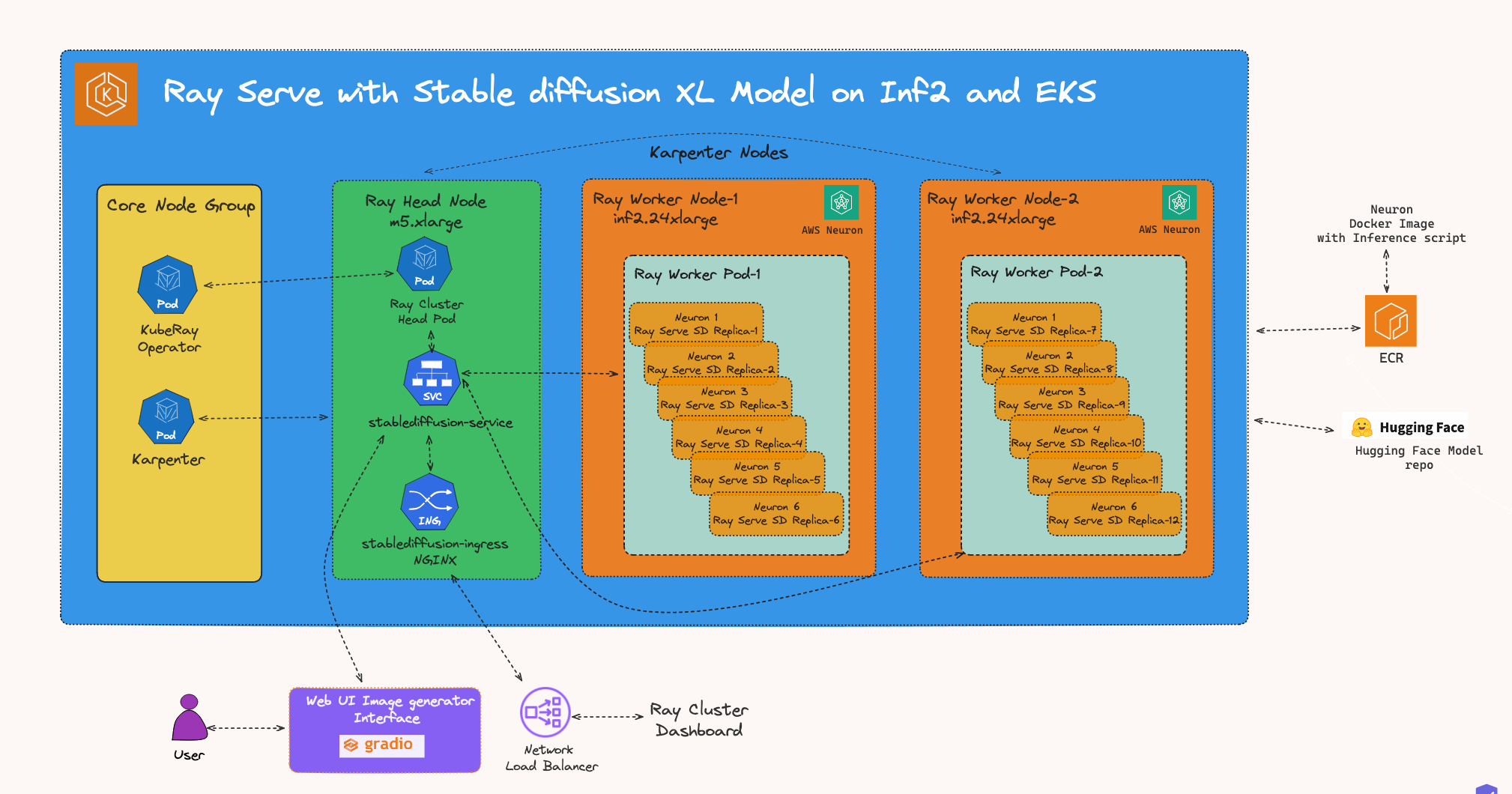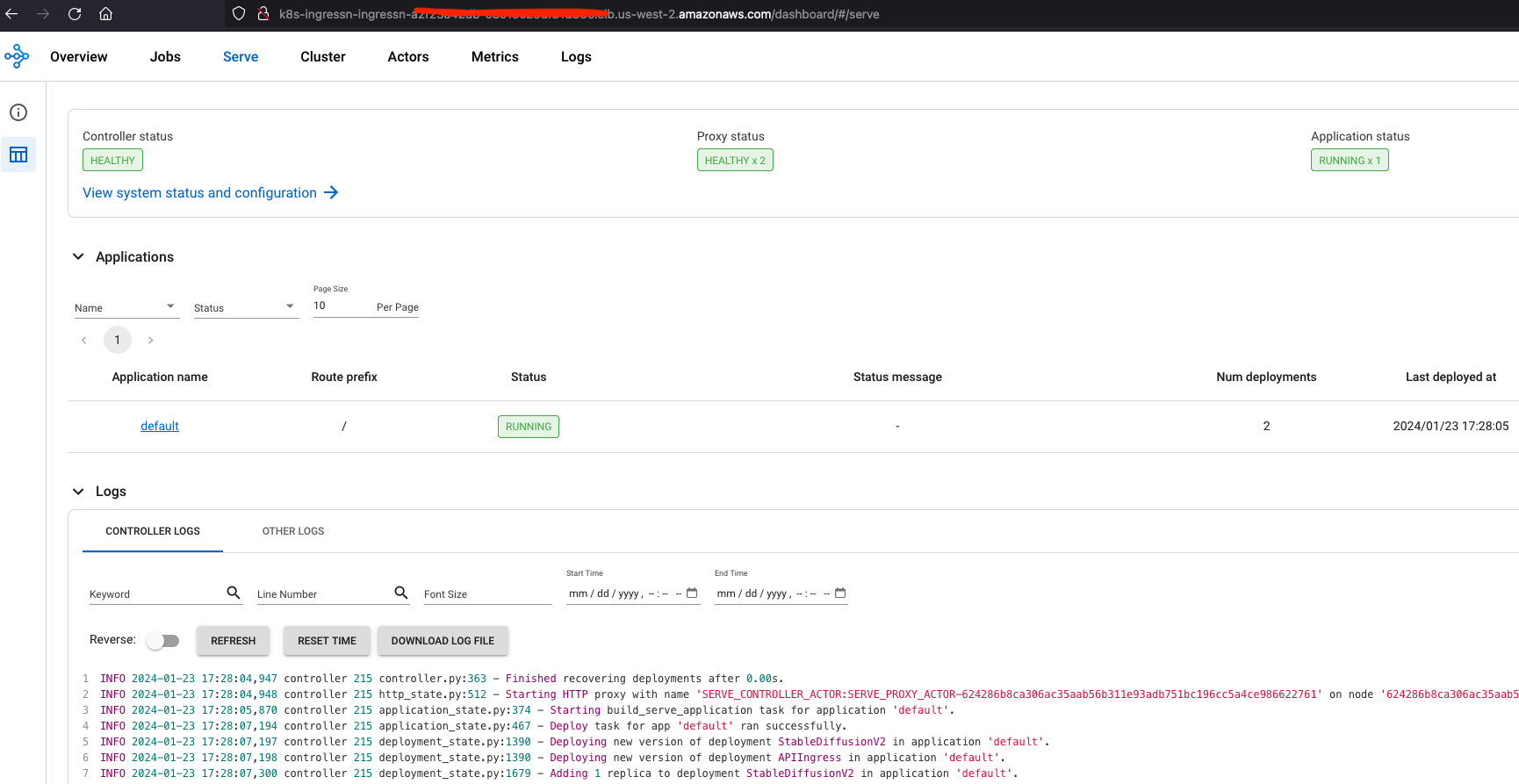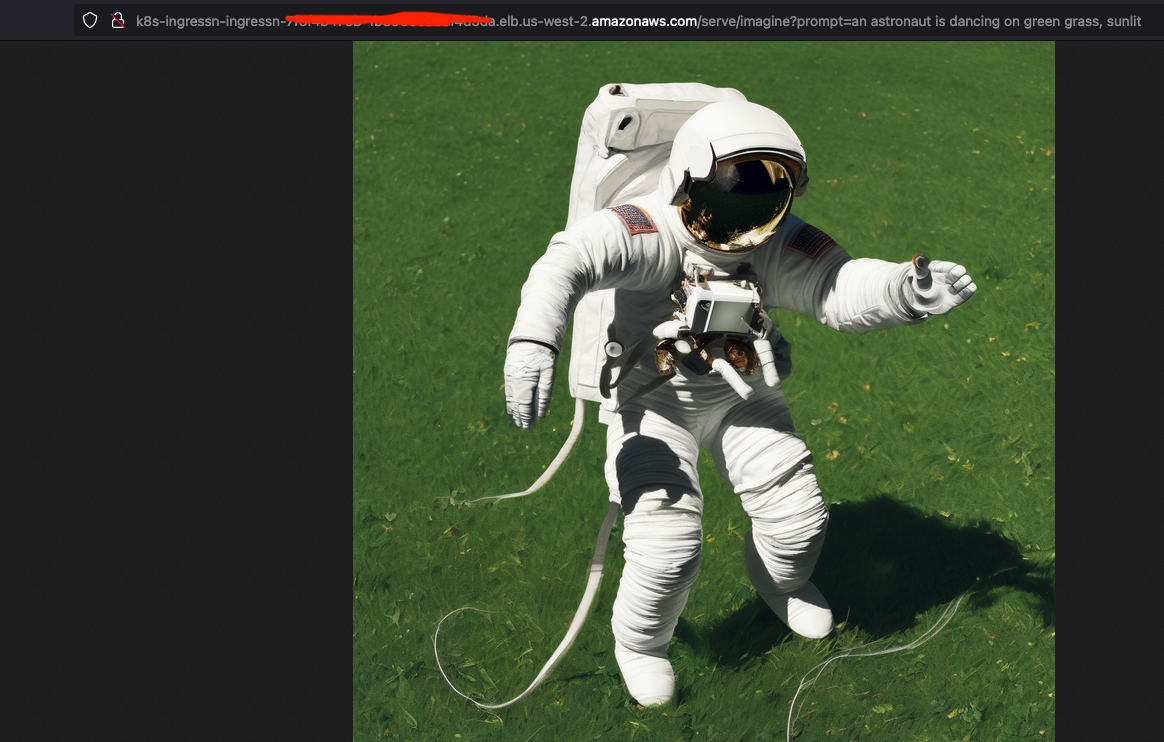The AI on EKS content is being migrated to a new repository. 🔗 👉 Read the full migration announcement »
Deployment of ML models on EKS requires access to GPUs or Neuron instances. If your deployment isn't working, it’s often due to missing access to these resources. Also, some deployment patterns rely on Karpenter autoscaling and static node groups; if nodes aren't initializing, check the logs for Karpenter or Node groups to resolve the issue.
This example blueprint deploys a stable-diffusion-xl-base-1-0 model on Inferentia2 instance running as a worker node in an EKS cluster. The model is served using RayServe.
Serving Stable Diffusion XL Base Model with Inferentia, Ray Serve and Gradio
Welcome to the comprehensive guide on deploying the Stable Diffusion XL Base model on Amazon Elastic Kubernetes Service (EKS) using Ray Serve.
In this tutorial, you will not only learn how to harness the power of Stable Diffusion models, but also gain insights into the intricacies of deploying large language models (LLMs) efficiently, particularly on trn1/inf2 (powered by AWS Trainium and Inferentia) instances, such as inf2.24xlarge and inf2.48xlarge,
which are optimized for deploying and scaling large language models.
What is Stable Diffusion?
Stable Diffusion is a text-to-image model for creating stunning art within seconds. It is one of the largest and most powerful LLMs available today. It is primarily used to generate detailed images conditioned on text descriptions, though it can also be applied to other tasks such as inpainting, outpainting, and generating image-to-image translations guided by a text prompt.
Stable Diffusion XL(SDXL)
SDXL is a latent diffusion model for text-to-image synthesis. Compared to previous versions of Stable Diffusion, SDXL uses pipelines for latent diffusion and noise reduction. SDXL also improves the quality of generated images compared to prior Stable Diffusion models by using a times larger UNet. The increase of model parameters is mainly due to more attention blocks and a larger cross-attention context as SDXL uses a second text encoder.
SDXL has been designed with multiple novel conditioning schemes and trained on multiple aspect ratios. It also uses a refinement model which is used to improve the visual fidelity of samples generated by SDXL using a post-hoc image-to-image technique.
This process results in a highly capable and fine-tuned language model that we will guide you to deploy and utilize effectively on Amazon EKS with Ray Serve.
Inference on Trn1/Inf2 Instances: Unlocking the Full Potential of Stable Diffusion LLMs
Stable Diffusion XL can be deployed on a variety of hardware platforms, each with its own set of advantages. However, when it comes to maximizing the efficiency, scalability, and cost-effectiveness of Stable Diffusion models, AWS Trn1/Inf2 instances shine as the optimal choice.
Scalability and Availability
One of the key challenges in deploying large language models (LLMs) like StableDiffusion XL is the scalability and availability of suitable hardware. Traditional GPU instances often face scarcity due to high demand, making it challenging to provision and scale resources effectively.
In contrast, Trn1/Inf2 instances, such as trn1.32xlarge, trn1n.32xlarge, inf2.24xlarge and inf2.48xlarge, are purpose built for high-performance deep learning (DL) training and inference of generative AI models, including LLMs. They offer both scalability and availability, ensuring that you can deploy and scale your Stable-diffusion-xl models as needed, without resource bottlenecks or delays.
Cost Optimization: Running LLMs on traditional GPU instances can be cost-prohibitive, especially given the scarcity of GPUs and their competitive pricing. Trn1/Inf2 instances provide a cost-effective alternative. By offering dedicated hardware optimized for AI and machine learning tasks, Trn1/Inf2 instances allow you to achieve top-notch performance at a fraction of the cost. This cost optimization enables you to allocate your budget efficiently, making LLM deployment accessible and sustainable.
Performance Boost While Stable-Diffusion-xl can achieve high-performance inference on GPUs, Neuron accelerators take performance to the next level. Neuron accelerators are purpose-built for machine learning workloads, providing hardware acceleration that significantly enhances Stable-diffusion's inference speeds. This translates to faster response times and improved user experiences when deploying Stable-Diffusion-xl on Trn1/Inf2 instances.
Example usecase
A digital art company wants to deploy Stable-diffusion-xl powered image generator to help generate possible art based on prompts. Using a selection of textual prompts, users can create artwork, graphics and logos in a wide variety of styles. The image generator can be used to predict or fine-tune the art and can result in significant time saving in product iteration cycle. Company has a large customer base and wants the model to be scalable at high load. The company needs to design an infrastructure that can handle the high volume of requests and provide a fast response time.
The company can use Inferentia2 instances to scale its Stable diffusion image generator efficiently. Inferentia2 instances are specialized hardware accelerators for machine learning tasks. They can provide up to 20x better performance and up to 7x lower cost than GPUs for machine learning workloads.
The company can also use Ray Serve to horizontally scale its Stable diffusion image generator. Ray Serve is a distributed framework for serving machine learning models. It can automatically scale your models up or down based on demand.
To scale its Stable diffusion image generator, the company can deploy multiple Inferentia2 instances and use Ray Serve to distribute the traffic across the instances. This will allow the company to handle a high volume of requests and provide a fast response time.
Solution Architecture
In this section, we will delve into the architecture of our solution, which combines Stable diffusion xl model, Ray Serve and Inferentia2 on Amazon EKS.

Deploying the Solution
To get started with deploying stable-diffusion-xl-base-1-0 on Amazon EKS, we will cover the necessary prerequisites and guide you through the deployment process step by step.
This includes setting up the infrastructure, deploying the Ray cluster, and creating the Gradio WebUI app.
Prerequisites
👈Deploying the Ray Cluster with Stable Diffusion XL Model
Once the Trainium on EKS Cluster is deployed, you can proceed to use kubectl to deploy the ray-service-stablediffusion.yaml.
In this step, we will deploy the Ray Serve cluster, which comprises one Head Pod on x86 CPU instances using Karpenter autoscaling, as well as Ray workers on Inf2.48xlarge instances, autoscaled by Karpenter.
Let's take a closer look at the key files used in this deployment and understand their functionalities before proceeding with the deployment:
- ray_serve_stablediffusion.py: This script uses FastAPI, Ray Serve, and Hugging Face Optimum Neuron library of tools to create an efficient text to image generator using the Neuronx model for stable-diffusion-xl-base-1.0 language model.
For this example blueprint, we are using a precompiled model that's been compiled to run on AWS Neuron. You can use any stable diffusion model of your choice and compile it to run on AWS Neuron before driving inference on it.
- ray-service-stablediffusion.yaml:
This Ray Serve YAML file serves as a Kubernetes configuration for deploying the Ray Serve service, facilitating efficient text generation using the
stable-diffusion-xl-base-1.0model. It defines a Kubernetes namespace namedstablediffusionto isolate resources. Within the configuration, theRayServicespecification, namedstablediffusion-service, is created and hosted within thestablediffusionnamespace. TheRayServicespecification leverages the Python scriptray_serve_stablediffusion.py(copied into the Dockerfile located within the same folder) to create the Ray Serve service. The Docker image used in this example is publicly available on Amazon Elastic Container Registry (ECR) for ease of deployment. Users can also modify the Dockerfile to suit their specific requirements and push it to their own ECR repository, referencing it in the YAML file.
Deploy the Stable-Diffusion-xl-base-1-0 Model
Ensure the cluster is configured locally
aws eks --region us-west-2 update-kubeconfig --name trainium-inferentia
Deploy RayServe Cluster
cd data-on-eks/gen-ai/inference/stable-diffusion-xl-base-rayserve-inf2
kubectl apply -f ray-service-stablediffusion.yaml
Verify the deployment by running the following commands
The deployment process may take up to 10 minutes. The Head Pod is expected to be ready within 2 to 3 minutes, while the Ray Serve worker pod may take up to 10 minutes for image retrieval and Model deployment from Huggingface.
$ kubectl get po -n stablediffusion -w
NAME READY STATUS RESTARTS AGE
service-raycluster-gc7gb-worker-inf2-worker-group-k2kf2 0/1 Init:0/1 0 7s
stablediffusion-service-raycluster-gc7gb-head-6fqvv 1/1 Running 0 7s
service-raycluster-gc7gb-worker-inf2-worker-group-k2kf2 0/1 PodInitializing 0 9s
service-raycluster-gc7gb-worker-inf2-worker-group-k2kf2 1/1 Running 0 10s
stablediffusion-service-raycluster-gc7gb-head-6fqvv 1/1 Running 0 53s
service-raycluster-gc7gb-worker-inf2-worker-group-k2kf2 1/1 Running 0 53s
Also check the service and ingress resources that got created
kubectl get svc -n stablediffusion
NAME TYPE CLUSTER-IP EXTERNAL-IP PORT(S) AGE
stablediffusion-service NodePort 172.20.175.61 <none> 6379:32190/TCP,8265:32375/TCP,10001:32117/TCP,8000:30770/TCP,52365:30334/TCP,8080:30094/TCP 16h
stablediffusion-service-head-svc NodePort 172.20.193.225 <none> 6379:32228/TCP,8265:30215/TCP,10001:30767/TCP,8000:31482/TCP,52365:30170/TCP,8080:31584/TCP 16h
stablediffusion-service-serve-svc NodePort 172.20.15.224 <none> 8000:30982/TCP 16h
$ kubectl get ingress -n stablediffusion
NAME CLASS HOSTS ADDRESS PORTS AGE
stablediffusion-ingress nginx * k8s-ingressn-ingressn-7f3f4b475b-1b8966c0b8f4d3da.elb.us-west-2.amazonaws.com 80 16h
Now, you can access the Ray Dashboard from the Load balancer URL below.
http://<NLB_DNS_NAME>/dashboard/#/serve
If you don't have access to a public Load Balancer, you can use port-forwarding and browse the Ray Dashboard using localhost with the following command:
kubectl port-forward svc/stablediffusion-service 8265:8265 -n stablediffusion
# Open the link in the browser
http://localhost:8265/
From this webpage, you will be able to monitor the progress of Model deployment, as shown in the image below:

To Test the Stable Diffusion XL Model
Once you've verified that the Stable Diffusion model deployment status has switched to a running state in Ray Dashboard , you're all set to start leveraging the model. This change in status signifies that the Stable Diffusion model is now fully functional and prepared to handle your image generation requests based on textual descriptions."
You can use the following URL with a query added at the end of the URL.
http://<NLB_DNS_NAME>/serve/imagine?prompt=an astronaut is dancing on green grass, sunlit
You will see an output like this in your browser:

Deploying the Gradio WebUI App
Discover how to create a user-friendly chat interface using Gradio that integrates seamlessly with deployed models.
Let's move forward with setting up the Gradio app as a Docker container running on localhost. This setup will enable interaction with the Stable Diffusion XL model, which is deployed using RayServe.
Build the Gradio app docker container
First, lets build the docker container for the client app.
cd data-on-eks/gen-ai/inference/gradio-ui
docker build --platform=linux/amd64 \
-t gradio-app:sd \
--build-arg GRADIO_APP="gradio-app-stable-diffusion.py" \
.
Deploy the Gradio container
Deploy the Gradio app as a container on localhost using docker:
docker run --rm -it -p 7860:7860 -p 8000:8000 gradio-app:sd
If you are not running Docker Desktop on your machine and using something like finch instead then you will need to additional flags for a custom host-to-IP mapping inside the container.
docker run --rm -it \
--add-host ray-service:<workstation-ip> \
-e "SERVICE_NAME=http://ray-service:8000" \
-p 7860:7860 gradio-app:sd
Invoke the WebUI
Open your web browser and access the Gradio WebUI by navigating to the following URL:
Running on local URL: http://localhost:7860
You should now be able to interact with the Gradio application from your local machine.

Conclusion
In conclusion, you will have successfully deployed the Stable-diffusion-xl-base model on EKS with Ray Serve and created a prompt based web UI using Gradio. This opens up exciting possibilities for natural language processing and prompt based image generator and image predictor development.
In summary, when it comes to deploying and scaling Stable diffusion models, AWS Trn1/Inf2 instances offer a compelling advantage. They provide the scalability, cost optimization, and performance boost needed to make running large language models efficient and accessible, all while overcoming the challenges associated with the scarcity of GPUs. Whether you're building text-to-image generators, image-to-image generators or any other LLM-driven solution, Trn1/Inf2 instances empower you to harness the full potential of Stable Diffusion LLMs on the AWS cloud.
Cleanup
Finally, we'll provide instructions for cleaning up and deprovisioning the resources when they are no longer needed.
Step1: Delete Gradio Container
Ctrl-c on the localhost terminal window where docker run is running to kill the container running the Gradio app. Optionally clean up the docker image
docker rmi gradio-app:sd
Step2: Delete Ray Cluster
cd data-on-eks/gen-ai/inference/stable-diffusion-xl-base-rayserve-inf2
kubectl delete -f ray-service-stablediffusion.yaml
Step3: Cleanup the EKS Cluster
This script will cleanup the environment using -target option to ensure all the resources are deleted in correct order.
cd data-on-eks/ai-ml/trainium-inferentia/
./cleanup.sh